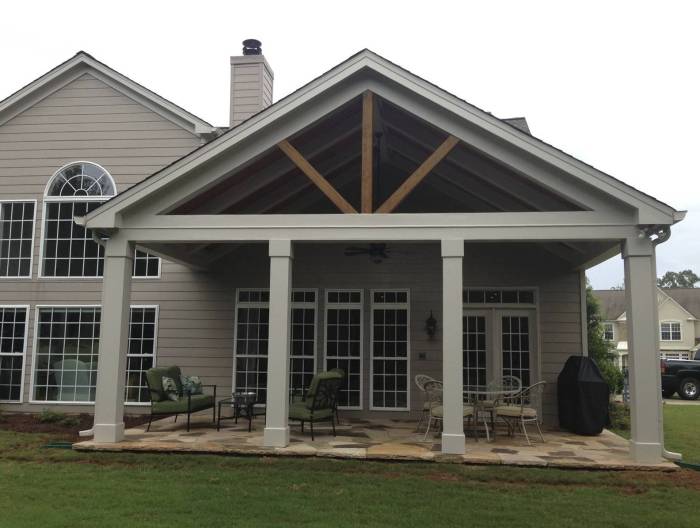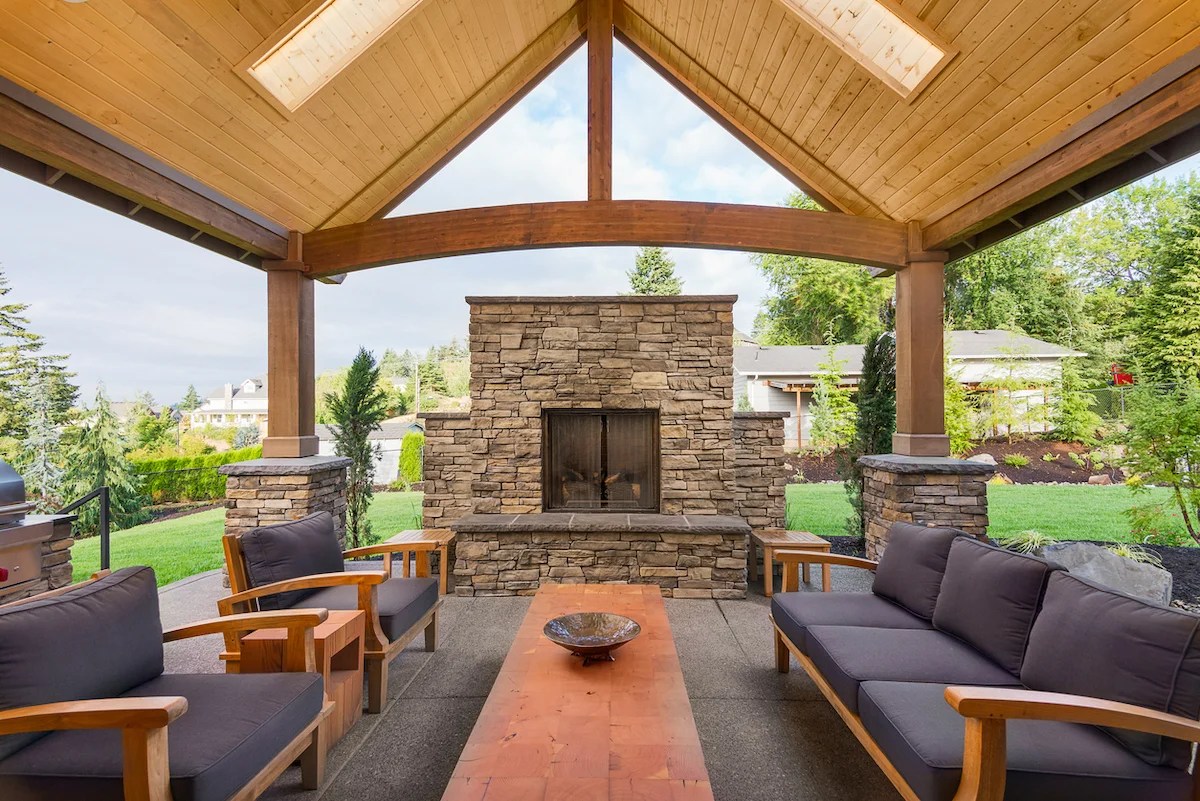Envision a welcoming outdoor sanctuary, a haven where you can unwind, entertain, and embrace the beauty of nature. The roof of your porch plays a pivotal role in defining this space, not only providing shelter but also adding character and architectural interest.
Explore the myriad roof designs available for porches, each with its unique advantages and aesthetic appeal, and embark on a journey to transform your porch into an enchanting extension of your home.
From classic gable roofs to modern flat roofs, the options are endless. Discover the charm of traditional hip roofs, the elegance of shed roofs, and the versatility of curved roofs. Each design offers its own distinct advantages, whether it’s maximizing natural light, enhancing drainage, or creating a visually striking focal point.
Delve into the factors that influence your choice, such as the style of your home, the intended use of the porch, and your personal preferences, to find the perfect roof design that complements your vision.
Porch Roof Designs
Porch roofs are an important part of any home’s exterior. They provide shelter from the sun and rain, and can also add to the overall aesthetic of the home. There are many different types of porch roof designs to choose from, each with its own advantages and disadvantages.
Gable Roof
Gable roofs are the most common type of porch roof. They are simple to build and can be used on porches of any size. Gable roofs have two sloping sides that meet at a ridge in the center. They can be covered with a variety of materials, including shingles, metal, or tile.
Advantages:
- Simple to build
- Can be used on porches of any size
- Provides good drainage
Disadvantages:
- Can be more expensive than other types of roofs
- Can be difficult to repair
Hip Roof
Hip roofs are another popular type of porch roof. They have four sloping sides that meet at a peak in the center. Hip roofs are more difficult to build than gable roofs, but they are also more durable and can withstand higher winds.
Advantages:
- More durable than gable roofs
- Can withstand higher winds
- Provides good drainage
Disadvantages:
- More difficult to build
- Can be more expensive than gable roofs
Flat Roof
Flat roofs are a good option for porches that are not exposed to high winds. They are simple to build and can be covered with a variety of materials, including rubber, asphalt, or metal.
Advantages:
- Simple to build
- Can be covered with a variety of materials
- Less expensive than other types of roofs
Disadvantages:
- Not as durable as other types of roofs
- Can be difficult to drain
Shed Roof
Shed roofs are a good option for porches that are attached to the side of a house. They have one sloping side that extends from the house to the edge of the porch. Shed roofs are simple to build and can be covered with a variety of materials.
Advantages:
- Simple to build
- Can be covered with a variety of materials
- Less expensive than other types of roofs
Disadvantages:
- Not as durable as other types of roofs
- Can be difficult to drain
Factors to Consider When Choosing a Porch Roof Design
When selecting a porch roof design, several factors must be considered to ensure both functionality and aesthetic appeal. These factors include:
- Climate and weather conditions: The local climate and weather patterns should be taken into account. In areas with heavy rainfall, a steeply pitched roof is recommended to prevent water accumulation. In regions with strong winds, a low-pitched roof or one with a sturdy support structure is more suitable.
- Purpose and use of the porch: Consider the intended use of the porch. If it will be primarily used for relaxation and outdoor dining, a covered porch with a roof that provides shade and protection from the elements is ideal. For porches used as an extension of the living space, a roof with a higher pitch and more open design may be preferred to allow for natural light and ventilation.
- Architectural style of the house: The porch roof should complement the architectural style of the house. A traditional home may be suited to a gabled roof, while a contemporary home may opt for a flat or shed roof. Matching the roofline and materials to the existing structure creates a cohesive and visually appealing design.
- Budget and maintenance: The cost of the porch roof and its ongoing maintenance should be considered. Different materials and designs have varying price points and maintenance requirements. For example, metal roofs are durable and low-maintenance, but they can be more expensive than asphalt shingles.
- Personal preferences: Ultimately, the choice of porch roof design is a matter of personal preference. Consider the desired aesthetic, functionality, and overall vision for the porch to make an informed decision.
Prioritizing Factors
The importance of each factor may vary depending on individual needs and preferences. To prioritize the factors, consider the following steps:
- Identify essential factors: Determine the factors that are non-negotiable, such as climate compatibility or budget constraints.
- Rank the remaining factors: Assign a level of importance to the remaining factors based on personal preferences and the specific requirements of the porch.
- Make a decision: Weigh the factors and make a decision that balances the essential requirements with the desired aesthetic and functionality.
By carefully considering these factors and prioritizing them based on individual needs, you can select a porch roof design that meets both practical and aesthetic goals.
Design Elements of Porch Roofs
Design elements play a crucial role in enhancing the aesthetics and functionality of porch roofs. These elements include:
Roof Shape
- Gable roofs: Classic triangular shape, providing ample headroom and drainage.
- Hip roofs: Sloping sides that meet at a central ridge, offering increased wind resistance.
- Skillion roofs: Single-sloped roofs, creating a modern and minimalist look.
Roof Pitch
The angle of the roof’s slope determines the height and drainage capabilities.
Roofing Materials
- Shingles: Durable and affordable, available in various colors and styles.
- Metal: Lightweight, fire-resistant, and long-lasting.
- Tile: Elegant and durable, but requires professional installation.
Roof Trim
Fascia, soffit, and gutters add visual interest and protect the roof from water damage.
Incorporating Design Elements
To incorporate design elements into a porch roof design, consider the following:
- Match the house style: Choose a roof shape and materials that complement the overall architectural style of the house.
- Consider functionality: Ensure the roof provides adequate drainage and headroom for the intended use of the porch.
- Add decorative elements: Use trim, railings, or other decorative elements to enhance the aesthetic appeal of the porch.
Materials for Porch Roofs
The choice of material for your porch roof depends on several factors, including your budget, the style of your home, and the climate in your area. Here is a comparison of the different materials used for porch roofs:
Asphalt Shingles
- Affordable and easy to install
- Available in a variety of colors and styles
- Not as durable as other materials
- May require more frequent repairs
Metal Roofing
- Durable and long-lasting
- Fire-resistant and wind-resistant
- Can be noisy in heavy rain
- More expensive than asphalt shingles
Wood Shakes and Shingles
- Natural and attractive
- Durable and long-lasting
- Require regular maintenance and treatment
- More expensive than asphalt shingles
Tile Roofing
- Durable and long-lasting
- Fire-resistant and wind-resistant
- Heavy and expensive to install
- May not be suitable for all climates
Composite Shingles
- Durable and long-lasting
- Fire-resistant and wind-resistant
- More expensive than asphalt shingles
- May not be as attractive as natural materials
Construction Techniques for Porch Roofs
Constructing a sturdy and aesthetically pleasing porch roof requires careful planning and proper execution. Several construction techniques are commonly used, each with its own advantages and considerations.
To ensure the longevity and structural integrity of your porch roof, it’s crucial to adhere to industry standards and building codes. Skilled craftsmanship and attention to detail are paramount throughout the construction process.
Framing Techniques
- Stick Framing: Individual lumber pieces are cut and assembled on-site to create the roof structure. This technique offers flexibility and allows for customization, but requires more time and labor.
- Truss Framing: Prefabricated trusses are designed and manufactured off-site, then delivered and assembled on-site. Trusses provide a faster and more efficient construction method, but may limit design options.
Roofing Materials
- Asphalt Shingles: A popular and cost-effective option, asphalt shingles are durable, easy to install, and available in a wide range of colors and styles.
- Metal Roofing: Metal roofs are lightweight, durable, and energy-efficient. They come in various finishes and can enhance the aesthetic appeal of your porch.
- Wood Shakes and Shingles: These natural materials provide a rustic and charming look. However, they require more maintenance and may be susceptible to rot and insects.
Roofing Installation
- Underlayment: A protective layer is installed over the roof sheathing to prevent moisture penetration and enhance roof performance.
- Flashing: Metal strips are used to seal joints and prevent water leakage around chimneys, vents, and other roof penetrations.
- Shingle or Metal Installation: Roofing materials are installed according to the manufacturer’s specifications, ensuring proper overlap and watertightness.
Maintenance and Repair of Porch Roofs
To ensure the longevity and aesthetic appeal of your porch roof, regular maintenance and repairs are essential. Neglecting these tasks can lead to premature deterioration, costly repairs, and even safety hazards.
Maintaining your porch roof involves a series of proactive measures to prevent damage and extend its lifespan. Regular inspections, cleaning, and minor repairs can go a long way in preserving the integrity of your roof.
Maintenance Checklist
- Inspect regularly: Check your porch roof for any signs of damage, such as missing or damaged shingles, cracks, or leaks. Inspect after storms or heavy winds to ensure there is no damage.
- Clean regularly: Remove debris, leaves, and dirt from your porch roof to prevent water accumulation and potential leaks. Cleaning also helps prevent the growth of mold and mildew.
- Repair minor damage promptly: Address any small cracks, leaks, or missing shingles immediately to prevent further damage. These minor repairs can often be done by homeowners with basic DIY skills.
- Re-seal joints and flashing: Over time, joints and flashing around chimneys, vents, and other roof penetrations can deteriorate. Re-sealing these areas prevents water infiltration and potential leaks.
Troubleshooting Common Problems
Despite regular maintenance, porch roofs can develop issues over time. Here are some common problems and their potential solutions:
- Leaks: Leaks can occur due to damaged shingles, cracks, or faulty flashing. Inspect the roof thoroughly to identify the source of the leak and repair it accordingly.
- Sagging: Sagging can be caused by weakened roof supports or excessive weight on the roof. Contact a professional roofer to assess the situation and recommend appropriate repairs.
- Mold and mildew: Mold and mildew thrive in moist environments. Ensure proper ventilation and address any moisture issues to prevent their growth.
Closing Summary
As you embark on the journey of designing your porch roof, remember that it’s not just about functionality but also about creating a space that reflects your style and enhances your outdoor living experience. Consider the interplay of materials, textures, and colors to create a cohesive design that seamlessly blends with your home’s architecture.
Whether you opt for the timeless appeal of shingles, the rustic charm of wood shakes, or the sleek sophistication of metal, each material brings its own unique character to your porch. Embrace the opportunity to customize your roof design, incorporating decorative elements such as dormers, cupolas, or intricate trim, to make your porch a true reflection of your individuality.
With careful planning and attention to detail, your porch roof will become a captivating architectural element that adds value and beauty to your home for years to come.



